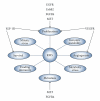Receptor tyrosine kinases as therapeutic targets in rhabdomyosarcoma
- PMID: 21253475
- PMCID: PMC3022188
- DOI: 10.1155/2011/756982
Receptor tyrosine kinases as therapeutic targets in rhabdomyosarcoma
Abstract
Rhabdomyosarcomas (RMSs) are the most common soft tissue sarcomas of childhood and adolescence. To date, there are no effective treatments that target the genetic abnormalities in RMS, and current treatment options for high-risk groups are not adequate. Over the past two decades, research into the molecular mechanisms of RMS has identified key genes and signaling pathways involved in disease pathogenesis. In these studies, members of the receptor tyrosine kinase (RTK) family of cell surface receptors have been characterized as druggable targets for RMS. Through small molecule inhibitors, ligand-neutralizing agents, and monoclonal receptor-blocking antibodies, RTK activity can be manipulated to block oncogenic properties associated with RMS. Herein, we review the members of the RTK family that are implicated in RMS tumorigenesis and discuss both the problems and promise of targeting RTKs in RMS.
Figures


References
-
- Parham DM. Pathologic classification of rhabdomyosarcomas and correlations with molecular studies. Modern Pathology. 2001;14(5):506–514. - PubMed
-
- Sorensen PHB, Lynch JC, Qualman SJ, et al. PAX3-FKHR and PAX7-FKHR gene fusions are prognostic indicators in alveolar rhabdomyosarcoma: a report from the Children’s Oncology Group. Journal of Clinical Oncology. 2002;20(11):2672–2679. - PubMed
Grants and funding
LinkOut - more resources
Full Text Sources
Other Literature Sources
Miscellaneous

